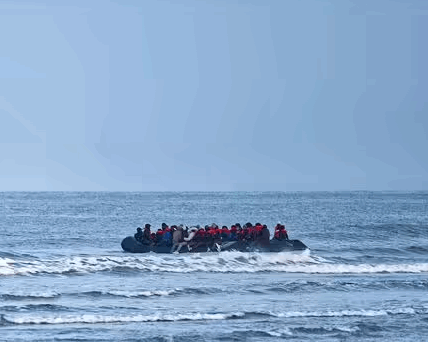The encampments, predominantly occupied by migrants from Sudan, Afghanistan and Georgia, have led to significant litter problems.

Migrants are gathered under police surveillance (Image: AFP via Getty Images)
Shocking pictures emerging today from Paris‘s infamous Stalingrad have shown French police clearing a makeshift migrant camp around the Metro station in the 10th and 19th arrondissements, with officers directing hundreds of individuals onto buses amid scattered tents, sleeping bags and piles of debris that had transformed busy streets into squalid encampments, sparking ongoing complaints over sanitation and public health.
Images depict the operation unfolding this morning, with evacuees – many carrying belongings in plastic bags – boarding vehicles bound for temporary shelters. This action takes place ahead of bi-weekly clearance operations set to launch formally on November 10 under the government’s extended “Plan Grand Froid” winter protocol, which will run through March 2026. The sweeps aim to tackle immediate risks from waste accumulation and falling temperatures, prioritising the relocation of vulnerable groups, including families, unaccompanied minors and individuals with medical conditions.

The so-called Stalingrad camp in Paris (Image: AFP via Getty Images)
The encampments, predominantly occupied by migrants from Sudan, Afghanistan and Georgia, have led to significant litter problems. Authorities report build-ups of food waste, discarded clothing, cardboard bedding and other refuse, which have overwhelmed local cleaning services and created hazards for both residents and the migrants themselves.
Local shop owners and passers-by have voiced frustration over blocked pavements and the visual blight on the neighbourhood, a key transport hub near the Canal Saint-Martin.
This latest flare-up – and today’s response – follows a series of recent interventions by the Paris prefecture. In early October, a major operation coordinated with police and NGOs such as Utopia 56 evicted between 400 and 500 people from the Stalingrad and adjacent Jaures areas.
Those affected were offered bus transfers to temporary shelters in northern suburbs, including Ivry-sur-Seine, along with options for relocation to other regions in France. Human rights organisations reported that up to 30 % of individuals declined the offers, expressing fears over being dispersed to remote locations without guarantees of long-term housing or access to support services.

Migrants are evacuated by bus under police surveillance (Image: AFP via Getty Images)
Just weeks later, on October 28, a smaller-scale clearance targeted a regrouping of about 150 people near Rue d’Aubervilliers. Described by Paris officials as a “preventive measure” to mitigate health and safety risks ahead of winter, the action involved the Brigade Anti-Criminalite (BAC) and municipal teams. It quickly escalated, with reports of pepper spray being used during minor clashes between officers and some evacuees. Social media accounts, including @ParisMigrantsWatch and @Utopia56, shared footage and eyewitness testimonies highlighting the tensions.
As of late October, the Stalingrad zone had remained under heightened surveillance by BAC units and city services. Despite the clearances, smaller groups had continued to reform on the pavements, sleeping in exposed conditions and contributing to ongoing waste issues. The recurrence underscores the challenges in the area, which has been a persistent hotspot for informal migrant settlements due to its central location and proximity to asylum processing centres.
Wednesday’s operation channels evacuees through the national 115 emergency hotline and partnerships with Samu Social for immediate shelter placements. Enforcement measures include potential fines of up to £132 (€150) for unauthorised camping, as well as referrals to immigration authorities for asylum claim processing.

Police stand in front of migrants as they clear a camp under the overhead railway line at Stalingrad (Image: AFP via Getty Images)
To bolster capacity, the Paris prefecture has allocated £2.2 million (€2.5 million) for 2025-2026, funding an additional 1,200 emergency beds across the city.
A specific pilot programme in Stalingrad seeks to convert vacant buildings into short-term “rapid housing” units, with implementation targeted for the first quarter of 2026. Officials describe this as part of a broader strategy to move beyond reactive clearances towards more sustainable solutions.
NGOs, including La Cimade and Utopia 56, have criticised the measures as superficial, pointing to migrants’ frequent returns within days. This pattern is attributed to exhausted asylum backlogs – with over 150,000 cases pending nationwide as of September 2025 – and chronic shortages of unconditional accommodation.
Social media threads have amplified these concerns, documenting not only the human cost but also the daily disruptions for locals, from delayed commutes to increased demands for refuse collection – with today’s images likely to fuel further debate.
In a November 2 interview on TF1, Interior Minister Gérald Darmanin attributed the ongoing crisis to stalled progress on the European Union‘s Migration Pact.
He said: “Sustainable solutions require EU-wide burden-sharing,” calling on member states to accelerate implementation and ease the pressure on frontline cities like Paris.
Paris prefecture representatives emphasise that the operations strike a balance between maintaining public order and providing humanitarian aid.
However, as the first frosts of winter approach, the cycle of encampment and eviction – now marked by this morning’s intervention – shows few signs of breaking, leaving the Stalingrad community bracing for further strain on its resources and resilience.

